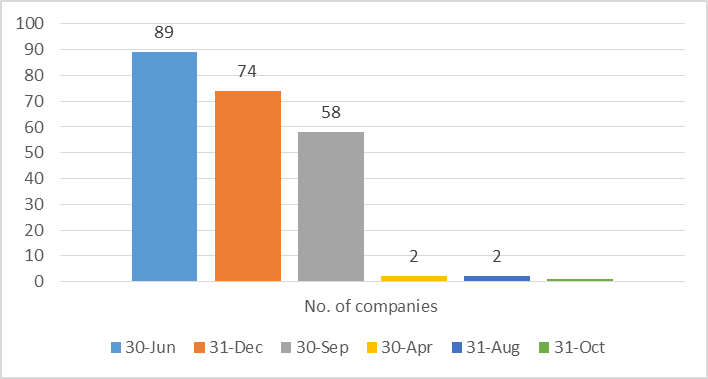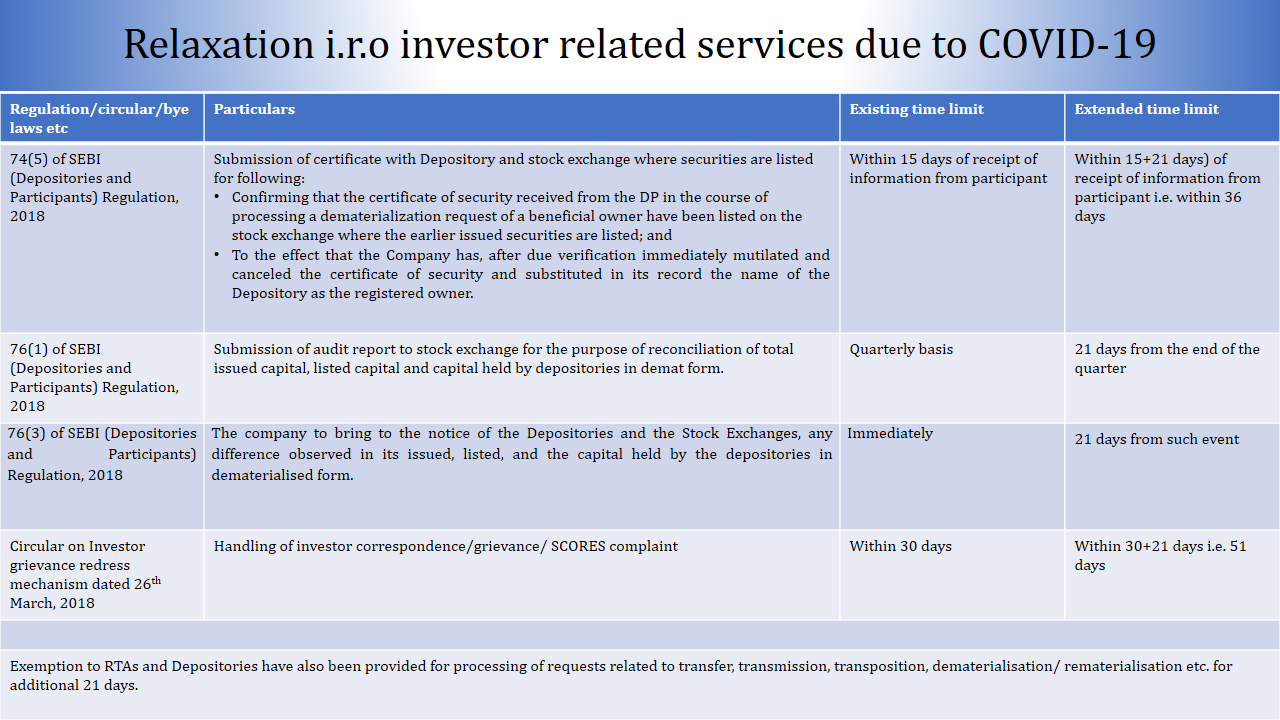Highlights of SEBI’s temporary relaxations for Rights Issue
Ambika Mehrotra & Ankit Vashishth
In line with various other relaxations introduced by the Securities and Exchange Board of India (‘SEBI’), amid the global pandemic, it has now come up with a Circular dated 21st April, 2020 [1]granting temporary relief under certain provisions of the SEBI (Issue of Capital and Disclosure Requirements) Regulations, 2018 (‘ICDR regulations’) in respect of Rights Issue. The rights issues opening on or before March 31, 2021 will get benefited from the said Circular.
It goes without saying that during the period of this of economical breakdown, the industrial undertakings are in need of funds for various purposes. In this hour of crisis, SEBI’s move seems to ease out the stringent requirements in the statues which hamper the facility of raising funds by companies especially through rights issue.
The amended provisions broadly serve the intent of having a relatively flexible eligibility criteria for a fast track rights issue and lesser chances of refund of the amount in case of non- receipt of subscription amount.
A snapshot of the relaxations and their impact is enlisted below: –
Eligibility conditions related to Fast Track Rights Issues
| Relevant Regulation
|
Pre- amendment | Post-amendment | Impact Analysis |
| 99(a) | the equity shares of the issuer have been listed on any stock exchange for a period of at least three years immediately preceding the reference date
|
the equity shares of the issuer have been listed on any stock exchange for a period of at least eighteen months immediately preceding the reference date
|
Relaxation in the pre-condition with respect to listing of equity shares from 3 years to 18 months. |
| 99(c ) | the average market capitalisation of public shareholding of the issuer is at least two hundred and fifty crore rupees
|
the average market capitalisation of public shareholding of the issuer is at least one hundred crores
|
Companies with smaller market size i.e. more Rs. 100 crore and above also permitted to enter into Fast Track Issue. |
| 99(f) and its proviso | the issuer has been in compliance with the equity listing agreement or the Securities and Exchange Board of India (Listing Obligations and Disclosure Requirements) Regulations, 2015, as applicable, for a period of at least three years immediately preceding the reference date:
Provided that if the issuer has not complied with the provisions of the listing agrîment or the Securities and Exchange Board of India (Listing Obligations and Disclosure Requirements) Regulations, 2015, as applicable, relating to composition of board of directors, for any quarter during the last three years immediately preceding the reference date, but is compliant with such provisions at the time of filing of letter of offer, and adequate disclosures are made in the letter of offer about such non-compliances during the three years immediately preceding the reference date, it shall be deemed as compliance with the condition; |
the issuer has been in compliance with the equity listing agreement or the Securities and Exchange Board of India (Listing Obligations and Disclosure Requirements) Regulations, 2015, as applicable, for a period of at least eighteen months immediately preceding the reference date:
Provided that if the issuer has not complied with the provisions of the listing agreement or the Securities and Exchange Board of India (Listing Obligations and Disclosure Requirements) Regulations, 2015, as applicable, relating to composition of board of directors, for any quarter during the last eighteen months immediately preceding the reference date, but is compliant with such provisions at the time of filing of letter of offer, and adequate disclosures are made in the letter of offer about such non-compliances during the three years immediately preceding the reference date, it shall be deemed as compliance with the condition;
|
The timeline for being in compliance with listing regulations has been reduced from 3 years to 18 months.
This is in line with the requirement under Regulation 99(a) wrt listing of equity shares for a period of atleast 18 months instead of 3 years. |
| 99(h) | No show-cause notices have been issued or prosecution proceedings have been initiated by the SEBI and pending against the issuer or its promoters or whole-time directors as on the reference date. | No show-cause notices, excluding under adjudication proceedings, have been issued by the SEBI and pending against the issuer or its promoters or whole-time directors as on the reference date.
In cases where against the issuer or its promoters/ directors/ group companies,
i. a show cause notice(s) has been issued by the Board in an adjudication proceeding or
ii. prosecution proceedings have been initiated by the Board; necessary disclosures in respect of such action (s) along-with its potential adverse impact on the issuer shall be made in the letter of offer. |
Regulation 99(h) restricts the company to make fast track rights issue in case there had been any show-cause notices or prosecution proceedings issued/initiated against the company/ its promoters/ WTDs.
The temporary relaxation however allows the company to be eligible for rights issue to the extent where adjudication proceedings or prosecution proceedings in respect of the above as well as the group companies are concerned, on making the required disclosures in this regard and its adverse impact, in the letter of offer |
| 99(i) | the issuer or promoter or promoter group or director of the issuer has not settled any alleged violation of securities laws through the consent or settlement mechanism with the Board during three years immediately preceding the reference date;
|
The issuer or promoter or promoter group or director of the issuer has fulfilled the settlement terms or adhered to directions of the settlement order(s) in cases where it has settled any alleged violation of securities laws through the consent or settlement mechanism with the Board. | Prior to the relaxation, any violation in the securities laws by the issuer/ promoter/ promoter group/ director made the issuer ineligible. This however has now been relaxed to permit the issue in case the above violators, having violated the securities laws at anytime during the past have fulfilled the settlement terms or followed the directions under the settlement order(s) |
| 99(j) | The equity shares of the issuer have not been suspended from trading as a disciplinary measure during last 3 years immediately preceding the reference date. | The equity shares of the issuer have not been suspended from trading as a disciplinary measure during last 18 months immediately preceding the reference date. | In line with Regulation 99(a) and (f) |
| 99(m) | There are no audit qualifications on the audited accounts of the issuer in respect of those financial years for which such accounts are disclosed in the letter of offer | For audit qualifications, if any, in respect of any of the financial years for which accounts are disclosed in the letter of offer, the issuer shall provide the restated financial statements adjusting for the impact of the audit qualifications.
Further, that for the qualifications wherein impact on the financials cannot be ascertained the same shall be disclosed appropriately in the letter of offer. |
Prior to the Circular, any qualification in the audit report led to ineligibility. This condition has now been re-framed to make the companies eligible on providing the restated financial statements adjusting for the impact of the audit qualifications or providing clarifications in case such impact cannot be ascertained |
Relaxation with respect to Minimum Subscription:
| Relevant Regulation
|
Pre- amendment | Post-amendment | Remarks |
| 86(1) | The minimum subscription to be received in the issue shall be at least ninety per cent. of the offer through the offer document. | The minimum subscription to be received in the issue shall be at least seventy five percent of the offer through the offer document.
Provided that if the issue is subscribed between 75% to 90%, issue will be considered successful subject to the condition that out of the funds raised atleast 75% of the issue size shall be utilized for the objects of the issue other than general corporate purpose. |
The minimum subscription amount has been reduced from 90% to 75%.
However, the Circular seems to put another restriction on the utilization of atleast 75% of the funds for the objects of the issue other than general corporate purpose if the actual subscription goes beyond 75% but within 90% of the offer. |
Minimum threshold for not filing draft letter of offer
| Relevant Regulation
|
Pre- amendment | Post-amendment | Remarks |
| Applicability of the Regulations:
3(b) |
rights issue by a listed issuer; where the aggregate value of the issue is ten crore rupees or more;
|
rights issue by a listed issuer; where the aggregate value of the issue is twenty-five crores or more;
|
The conditions prescribed in Chapter III of ICDR Regulations shall not apply in case of Rights Issue carrying an issue size of less than Rs. 25 crores. |
|
Proviso to Reg. 3 |
Provided that in case of rights issue of size less than ten crore rupees, the issuer shall prepare the letter of offer in accordance with requirements as specified in these regulations and file the same with the Board for information and dissemination on the Board’s website. | Provided that in case of rights issue of size less than twenty-five crore rupees, the issuer shall prepare the letter of offer in accordance with requirements as specified in these regulations and file the same with the Board for information and dissemination on the Board’s website. | The change is made considering the revised limit of applicability of the Regulations for a rights issue. |
|
60 |
Unless otherwise provided in this Chapter, an issuer offering specified securities of aggregate value of ten crore rupees or more, through a rights issue shall satisfy the conditions of this Chapter | Unless otherwise provided in this Chapter, an issuer offering specified securities of aggregate value twenty-five crore rupees or more, through a rights issue shall satisfy the conditions of this Chapter. | The change is made considering the revised limit of applicability of the Regulations for a rights issue. |
One-time Relaxation on opening of issue
In addition to the above Circular, SEBI has also issued another circular on the same date i.e. April 21, 2019[2] for granting one-time relaxation on the basis of the representations received from various stakeholders with respect to the opening of issue period within 12 months from the date of issuance of the observations by SEBI, for an Initial Public Offer (IPO), Further Public Offer (FPO) or Rights Issue as per Regulation 44, 140 and 85 respectively of the ICDR Regulations, expiring during this period of lockdown i.e. between March 1, 2020 and September 30, 2020 to be extended by 6 months, from the date of expiry of the above-mentioned observations received from SEBI.
However, the extension to this issue opening period shall be granted on obtaining an undertaking from lead manager of the issue confirming compliance with Schedule XVI of the ICDR Regulations with respect to the nature of changes in the offer document which require filing of updated offer document, while submitting the updated offer document to SEBI.
Conclusion
These temporary relaxations will surely bring in a sigh of relief for the stakeholders including the companies intending to raise funds through rights issue, during this interim period of disruption due the outbreak of COVID-19, considering the stagnancy of operations in the country.
Read our related articles below –
SEBI ICDR Regulations, 2018– Snapshot on changes in rights, bonus, QIP and preferential issue;
SEBI (ICDR) Regulations, 2018-Key Amendments;
Covid-19 – Incorporated Responses | Regulatory measures in view of COVID-19.
[1] https://www.sebi.gov.in/legal/circulars/apr-2020/relaxations-from-certain-provisions-of-the-sebi-issue-of-capital-and-disclosure-requirements-regulations-2018-in-respect-of-rights-issue_46537.html
[2] https://www.sebi.gov.in/legal/circulars/apr-2020/one-time-relaxation-with-respect-to-validity-of-sebi-observations_46536.html


